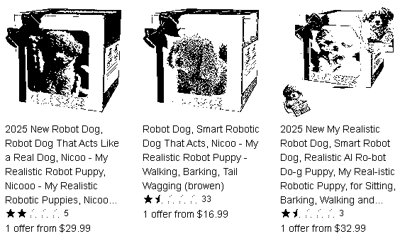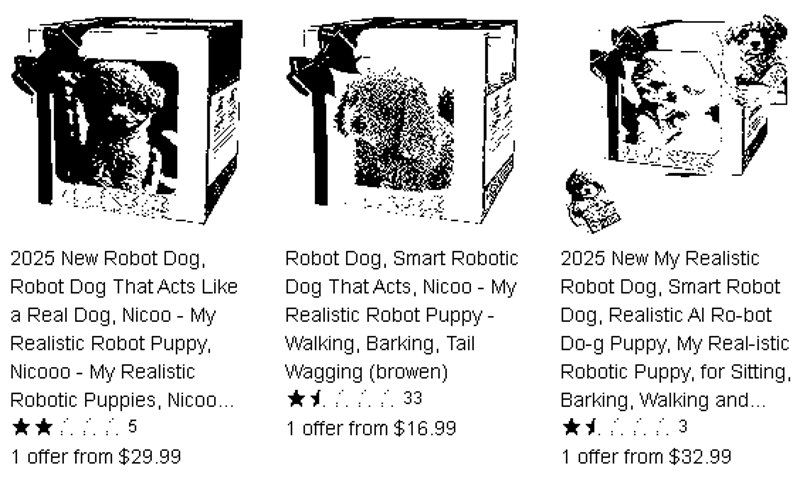As the festive frenzy kicks into high gear, our digital landscapes – from the hallowed halls of online marketplaces to the relentless scroll of social media – are awash with a peculiar new breed of canine: the ‘AI’ robot dog, sporting suspiciously bargain-basement price tags. Leading the pack of these digital distractions is the much-hyped Nico robot dog, a pixelated prodigy advertised through a shimmering veil of impressive, often AI-generated, videos depicting astonishingly lifelike — and entirely fictional — behaviours. Yet, peel back the glossy veneer, and consumer reports, alongside diligent investigations, consistently reveal a rather less sophisticated truth: these are, by and large, simple, low-quality toys, utterly devoid of genuine artificial intelligence, peddled with descriptions that stretch credulity and prices that inflate expectations beyond all reasonable measure.

Behind the curtain of those slick, often entirely fabricated video demonstrations – the kind that make you wonder if the animators moonlight for Pixar – these ‘robotic pets’ are, more often than not, glorified plush toys. Their repertoire? A handful of pre-programmed wiggles and bleeps, about as ‘intelligent’ as a particularly stubborn toaster. Unsurprisingly, the chorus of customer reviews sings a familiar tune of profound disappointment. Buyers recount receiving a flimsy, cheap-materialled contraption that bears about as much resemblance to the advertised AI marvel as a garden gnome does to a sentient space probe. But it’s not all just a humorous tale of digital disillusionment. A far more insidious worry lurks beneath the surface: potential safety hazards. These unverified electronics often house poorly manufactured lithium-ion batteries, ticking time bombs that pose a very real risk of fire or chemical leakage – hardly the kind of ‘surprise’ anyone wants under the Christmas tree.
So, before you succumb to the siren song of a ‘deal’ that whispers sweet nothings about being ’too good to be true’ – because, let’s be honest, it almost certainly is – a moment of judicious due diligence is not just critical; it’s practically a civic duty. Future robot dog owners should embark on a digital archaeological dig for independent reviews, scrutinise seller ratings with the intensity of a forensic accountant, and approach any generic testimonials plastered across the product’s own website with the kind of healthy scepticism usually reserved for politicians’ promises. Should a listing betray its deceptive nature, consumer advocacy stalwarts like Adhoc Support CIC urge a prompt report directly to the marketplace, and, crucially, to organisations dedicated to tracking systemic consumer harm. After all, nobody wants to be the unwitting pioneer in a new wave of festive tech disappointment.
Why this matters, beyond the giggles and grimaces
This burgeoning trend isn’t just another retail scam; it’s a stark glimpse into the new, often murky, frontier of online deception, supercharged by the dazzling, yet morally ambiguous, capabilities of generative AI. Consider it the classic bait-and-switch, but now injected with a potent cocktail of convincing deepfake videos and marketing copy that can be churned out at a scale previously unimaginable – a digital illusion factory running on silicon dreams. This phenomenon, aptly dubbed ‘AI-washing’ – the art of attributing sophisticated artificial intelligence capabilities to what is, in essence, a glorified electronic toy – doesn’t merely fleece consumers of their hard-earned cash. It introduces tangible safety risks, particularly when these ostensibly ‘smart’ playthings, destined for children, fail to meet critical safety standards for batteries and materials. Think less ‘robot dog,’ more ‘potential fire hazard in a furry costume.’ Ultimately, this saga underscores a pressing, evolving need for an almost superhuman level of consumer scepticism and, dare we say, robust regulatory oversight. Because as AI tools continue to perfect the dark arts of crafting polished, persuasive, and utterly mendacious advertising, the line between digital dream and consumer nightmare becomes perilously thin.






